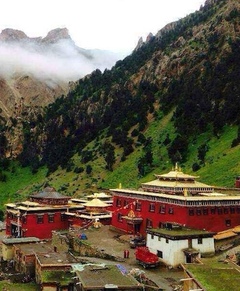Tana Monastery Praise
A Gorgeous Garland of Captivating Pearls
Praise for the Holy Site of Tana Monastery[1]
by Karma Tsultrim Tendar[2]
E ma! In the snowy land of Tibet,
Stands the marvelous, amazing site
Of Tana Monastery, Cakrasaṃvara’s palace.
From whatever angle you view it, it is a wonder.
In its eastern quarter is a self-arisen image of the King of Siddhas—[3]
A symbol of the countless scholars and yogis who have come here before.[4]
Its south side bears a self-arisen image of a victory banner,
Embodying the Dharma’s flourishing.[5]
On its western wing is a self-arisen dagger
Epitomizing the energy and power of the ngakpas.[6]
And in the north, a self-arisen image of Jambhala
Is a mark of power and wealth expanding.
Its rearward peak rises up to the heavens[7]
Symbolizing the sky-like vastness of the buddhas’ teachings.
The cliffs that frame it exude an opaline glow,
Expressing the accomplishment of the work of peace.[8]
The majestic, magnificent massif towering over it
Symbolizes seizing the throne of meditation.
This guarding mountain, this natural embodiment of the goddesses,[9]
Is a symbol of the devīs’ nurturing aid.
The blooming flowers of its meadows
Are signs of the gathering of the ḍākas and ḍākinīs.
The forests that surround it on all sides
Signify the sangha assembling from every direction.
The river that flows before it
Represents the uninterrupted flow of meditative experiences and realizations.
The boulders that pepper its terrain
Symbolize the spread of the buddhist canon far and wide.
The constant winds that howl through it
Symbolize scattering the five poisons’ ashes.
The scree that tumbles down the slopes like hail
Augurs ruin for the teachings’ enemies.
The sun rising early and setting late
Reflects this site’s early founding and recent disintegration.
This sublime place, marvelous Tana
Stands as beings’ undeniable beacon.
May my prayers come true to often visit
Sublime sites, exemplified by this holy place.
May the goodness of this bit of praise
Bring happiness to all beings who have been my mothers.
This was carefully composed at the beginning of the sixth month of the Iron Horse year[10] by one named Karma Tsultrim Tendar. Sarva maṅgalaṃ.
| Translated by Joseph McClellan with clarifications from Tana Dungse Rinpoche, 2024.
Bibliography
ʼGro mgon yel pa bkaʼ brgyud kyi gsung rab, vol. 1, pp. 207–208. BDRC W1ER145.
Martin, Dan. “Yelpa Yeshe Tsek.” Treasury of Lives, 2008. https://treasuryoflives.org/biographies/view/Yelpa-Yeshe-Tsek/TBRC_P5132
Version: 1.0-20240910
-
Tana Monastery is the seat of the Yelpa Kagyu lineage. It was founded by Sangye Yelpa, alias Yeshe Tsek in 1189 in the Nangchen region of Kham (Martin, “Yelpa Yeshe Tsek”). It was destroyed during the Cultural Revolution but has been reconstructed, while another branch has developed in South India under the direction of the late Tana Tulku and his son, Tana Dungse Rinpoche. See https://www.tanayelpa.org/tana-monasteries/. ↩
-
According to Tana Dungse Rinpoche, Karma Tsultrim Tendar is a contemporary Kagyu lama in Tibet. He served as Tana Monastery’s retreat master in the 1990s and is now Pelpung Monastery’s vajra master. ↩
-
According to Tana Dungse Rinpoche, grub rgyal (siddha king) here refers to the great traveling ecumenical master Thangtong Gyalpo (1361?–1485). ↩
-
The second and fourth lines of each stanza end with the term rtags. The most literal rendering would be “is a symbol of…” While Tibetan poetics relishes repetition, English poetics does not. We therefore use synonyms throughout, such as “symbolizes,” “signifies,” “embodies,” etc. ↩
-
In this and the previous line, the term “victory banner” (rgyal mtshan) is repeated. We again avoid repetition that would be tedious in English, rendering the second instance as “the flourishing of Dharma.” ↩
-
sngags pa—practitioners of mantra, tantrikas. ↩
-
Referring to the dramatic mountain with a pointy, rocky peak that inspired the name Tana (rta rna, “horse ear”). The first and third lines of this stanza and the next begin with the word rgyab (behind, background, rearward, etc.). We use synonyms rather than mirroring the Tibetan convention of repetition. ↩
-
One of four major kinds of tantric activity: pacifying, increasing, magnetizing, and subjugating. ↩
-
Chokgyur Lingpa wrote that the main mountain at Tana Monastery is the abode of a horse-faced ḍākinī. See https://www.tanayelpa.org/tana-monasteries/. ↩
-
Most likely corresponding to April–May 1990. ↩
